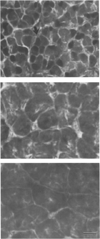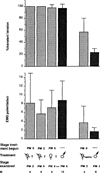Temporal constraints on androgen directed laryngeal masculinization in Xenopus laevis
- PMID: 1879612
- PMCID: PMC3493251
- DOI: 10.1016/s0012-1606(05)80023-5
Temporal constraints on androgen directed laryngeal masculinization in Xenopus laevis
Abstract
Temporal constraints on androgen regulated masculinization of three sexually dimorphic laryngeal properties--tension, fiber type, and fiber recruitment--were examined in Xenopus laevis frogs. Endocrine state was manipulated at PM0 when the larynx is similar in males and females, at PM2 when the larynx begins sexual differentiation, and at PM6 when sexual differentiation is complete. Removing the testes in developing males (PM0 or PM2) completely arrests laryngeal masculinization. Masculinization resumes when testosterone is replaced later in development (PM2 or PM6, respectively). Thus, testicular secretions, in particular androgens, are required for laryngeal masculinization. The ability of androgens to masculinize tension, fiber type, and fiber recruitment in developing and adult larynges was also determined. Five weeks of testosterone treatment in PM0 or PM2 males and females completely masculinizes laryngeal tension and fiber type, but only partially masculinizes fiber recruitment. However, fiber recruitment can be fully masculinized in PM6 males castrated at PM2. We conclude that androgen induced masculinization of tension and fiber type are not temporally constrained but that androgen induced masculinization of fiber recruitment is. Prolonged androgen treatment can override the temporal constraints on masculinization of the larynx. Testosterone treatment for more than 6 months fully masculinizes fiber recruitment in developing (PM0 or PM2) females. In addition, prolonged treatment (greater than 9 months) completely masculinizes tension, fiber type, and fiber recruitment in adult females; these properties were not fully masculinized by shorter (1-3 months) treatments in adult females. Testosterone induced masculinization in females is maintained for up to 8 months following testosterone removal; thus androgen effects are long lasting and possibly permanent.
Figures







Similar articles
-
The roles of sex, innervation, and androgen in laryngeal muscle of Xenopus laevis.J Neurosci. 1993 Jan;13(1):324-33. doi: 10.1523/JNEUROSCI.13-01-00324.1993. J Neurosci. 1993. PMID: 8423478 Free PMC article.
-
Development of functional sex differences in the larynx of Xenopus laevis.Dev Biol. 1991 Sep;147(1):251-9. doi: 10.1016/s0012-1606(05)80022-3. Dev Biol. 1991. PMID: 1879611 Free PMC article.
-
Hormone-sensitive stages in the sexual differentiation of laryngeal muscle fiber number in Xenopus laevis.Development. 1990 Nov;110(3):703-11. doi: 10.1242/dev.110.3.703. Development. 1990. PMID: 2088715 Free PMC article.
-
Neuroeffectors for vocalization in Xenopus laevis: hormonal regulation of sexual dimorphism.J Neurobiol. 1986 May;17(3):231-48. doi: 10.1002/neu.480170307. J Neurobiol. 1986. PMID: 3519865 Review.
-
Hormonal influences on sexually differentiated behavior in nonhuman primates.Front Neuroendocrinol. 2005 Apr;26(1):7-26. doi: 10.1016/j.yfrne.2005.02.001. Front Neuroendocrinol. 2005. PMID: 15862182 Review.
Cited by
-
Sexually dimorphic expression of a laryngeal-specific, androgen-regulated myosin heavy chain gene during Xenopus laevis development.Dev Biol. 1992 Dec;154(2):366-76. doi: 10.1016/0012-1606(92)90075-r. Dev Biol. 1992. PMID: 1426643 Free PMC article.
-
The roles of sex, innervation, and androgen in laryngeal muscle of Xenopus laevis.J Neurosci. 1993 Jan;13(1):324-33. doi: 10.1523/JNEUROSCI.13-01-00324.1993. J Neurosci. 1993. PMID: 8423478 Free PMC article.
-
Development of functional sex differences in the larynx of Xenopus laevis.Dev Biol. 1991 Sep;147(1):251-9. doi: 10.1016/s0012-1606(05)80022-3. Dev Biol. 1991. PMID: 1879611 Free PMC article.
-
Testicular masculinization of vocal behavior in juvenile female Xenopus laevis reveals sensitive periods for song duration, rate, and frequency spectra.J Comp Physiol A. 1992 Oct;171(3):343-50. doi: 10.1007/BF00223964. J Comp Physiol A. 1992. PMID: 1447723
-
Sexually differentiated, androgen-regulated, larynx-specific myosin heavy-chain isoforms in Xenopus tropicalis; comparison to Xenopus laevis.Dev Genes Evol. 2008 Jul;218(7):371-9. doi: 10.1007/s00427-008-0223-2. Epub 2008 Jun 13. Dev Genes Evol. 2008. PMID: 18551305 Free PMC article.
References
-
- Erulkar S, Wetzel D. 5α-Dihydrotestosterone has non-specific effects on membrane channels and possible genomic effects on ACh-activated channels. J. Neurophysiol. 1989;61:1036–1052. - PubMed
-
- Gorlick D, Kelley D. Neurogenesis in the vocalization pathway of Xenopus laevis. J. Comp. Neurol. 1987;254:614–627. - PubMed
-
- Herrera A, Werle M. Mechanisms of elimination, remodelling, and competition at frog neuromuscular junction. J. Neurobiol. 1990;21:73–98. - PubMed
-
- Herrera A, Banner L, Werle M, Regnier M, Nagaya-Stevens N. Postmetamorphic development of neuromuscular junctions and muscle fibers in the frog cutaneous pectoris. J. Neurobiol. 1991;22:15–28. - PubMed
-
- Jordan C, Letinsky M, Arnold A. Critical period for the androgenic block of neuromuscular synapse elimination. J. Neurobiol. 1990;21:760–767. - PubMed
Publication types
MeSH terms
Substances
Grants and funding
LinkOut - more resources
Full Text Sources

